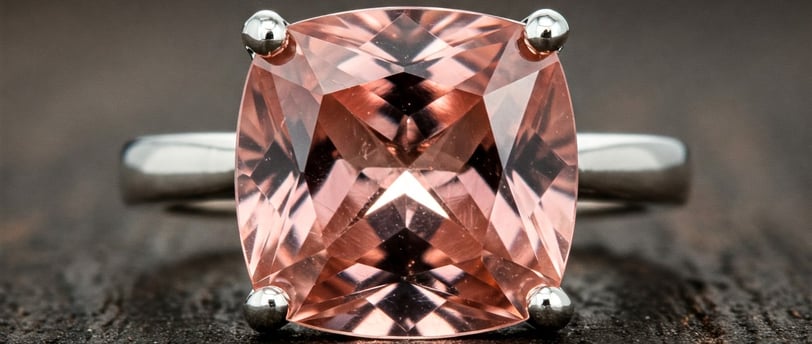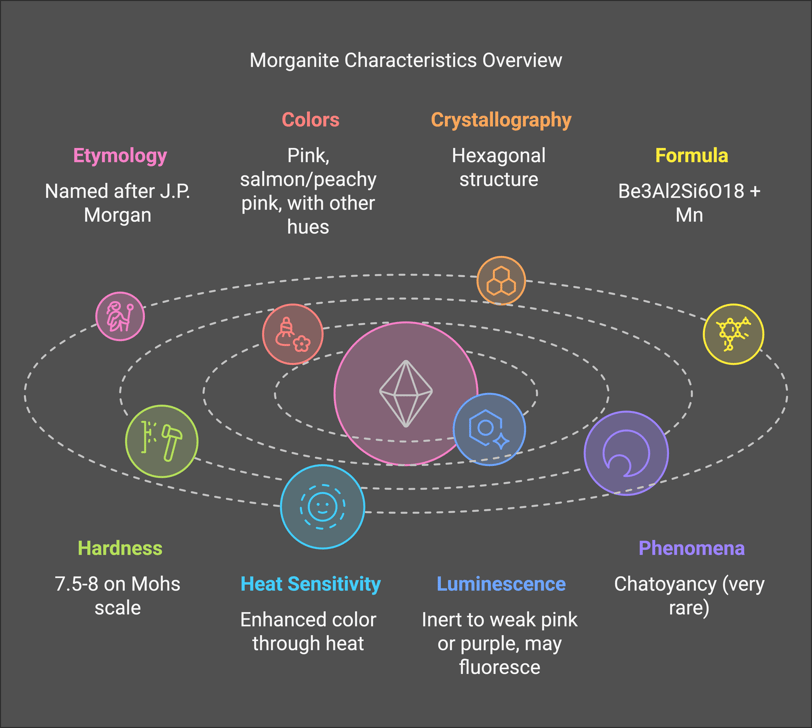Morganite
Morganite: Discover the Beauty of Pink Beryl, a durable and elegant gemstone that is perfect for any occasion.
1/30/20253 min read


History
Morganite, a member of the beryl family, has recently surged in popularity and value. It was named after the financier J.P. Morgan, an avid gem collector, by Tiffany & Co. after the gem's discovery in the early 20th century. Morganite was introduced to the American market after its discovery in Madagascar in 1910. George Kunz of Tiffany & Co. reportedly purchased as much of the gem as possible. Morganite's rarity contributes to its affordability because it isn't available in large quantities for manufactured jewelry. This makes morganite a gem for connoisseurs who value its soft shades and brilliance.
Mineral Origins
Morganite is a pink to orange-pink variety of beryl, a mineral that also includes emerald and aquamarine. The gemstone's color comes from the presence of manganese. Morganite crystals can be large, with some specimens from Brazil weighing over 10 kilograms. The state of Minas Gerais in Brazil currently produces most gem-quality morganite, although the deposit in Madagascar that produced the pink beryl first marketed as morganite has largely ceased production. Fine colored morganites can also be found in Afghanistan, China, Mozambique, Namibia, Russia, the United States, and Zimbabwe.
The 4 C’s
Color
Morganite is known for its pastel colors, including pink, purplish pink, and orangy pink. The most valued colors in today's market are the pink and rose tints. Although purplish morganites are less expensive than pink varieties, slightly purple hues can be quite beautiful. Some collectors prefer the unheated peachy color, and are willing to pay a premium to get an unenhanced, natural piece. Heat treatments are commonly used to reduce yellow hues, resulting in a more desirable pink color. The stone will appear pale pink from one direction and have a slight purple hue from another due to pleochroism. Morganite always has light tones, only reaching grades of 3 (very light). Even tones are the most valuable.
Clarity
Top-quality morganites should have clarity grades of VS or VVS, meaning they have very small or very very small inclusions. These stones are considered "eye-clean". Morganite's light tones can easily reveal inclusions, which will reduce the gem’s value. Transparent morganites are preferred for faceting. However, gem cutters can cab or carve more opaque, less valuable material.
Carat
While large morganites are available, the price per carat doesn't increase exponentially for this gem, and in fact, declines at about 20 carats. Consumers may prefer smaller gems with good color to larger stones. Very large morganites may require large cuts to show good color, and they can actually lose color when cut small enough for jewelry. The price of morganite increases with carat weight up to around 5 carats, after which the price per carat decreases.
Cut
Morganite is available in most cuts, including intricate designer cuts. The subtle colors of morganite lend themselves well to large gems. Morganite’s pleochroism requires careful orientation of the rough during cutting. Morganite is cut in standard as well as custom shapes and cutting styles.
Be Aware Of
Enhancements
Colorless or very light green to pink beryls may receive radiation as well as heat treatments to produce morganites. Heating salmon or peach-colored morganite is common, reducing yellow hues to create a more desirable pink color. These treatments are stable and won't require further care for the gem. However, some buyers prefer the stone’s natural color and will pay to ensure its authenticity.
Simulants
Near colorless beryl specimens may be offered for sale as morganites, but these should be labeled as goshenite, which is the colorless variety of beryl.
Synthetics
Synthetic morganites are available and may be difficult to distinguish from natural stones. Consult a gemological laboratory to distinguish between natural and synthetic gems.
Final Thoughts
Buying Tips
When buying morganite rough, evaluate it for clear crystal and good color, and avoid purchasing included rough unless the inclusions can be easily cut away. Be aware of synthetic stones and treatments. Medium light to medium pink, clean stones with custom cuts are the most valuable.
Jewelry Care
Morganite is durable, with a hardness of 7.5-8, and is suitable for everyday wear. To clean morganite jewelry, use a soft brush, mild detergent, and warm water. If free of inclusions or fractures, morganites may be cleaned using mechanical systems. It's recommended to have a gemologist examine the gems first to identify any potential weaknesses.


Gemius Stones
Expertise
© 2025. All rights reserved.
